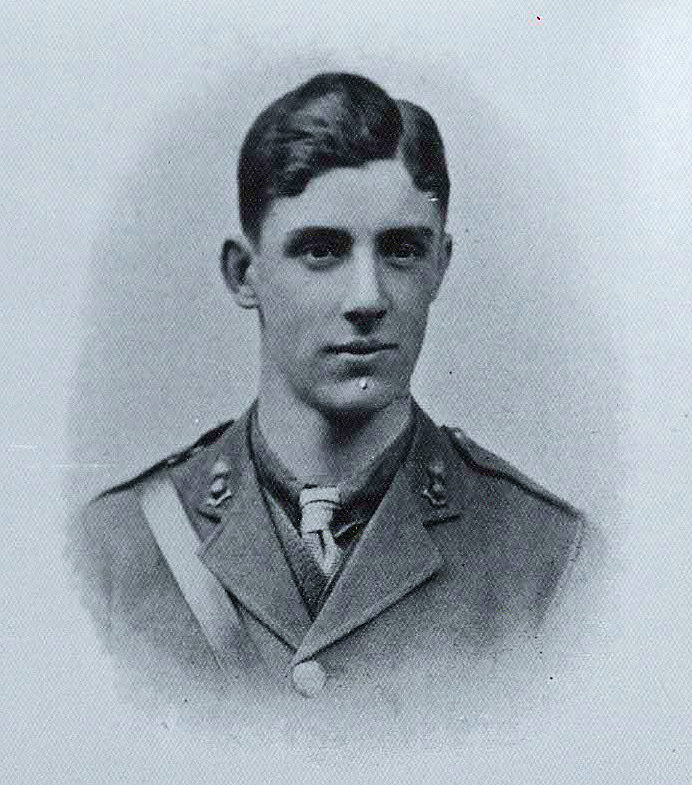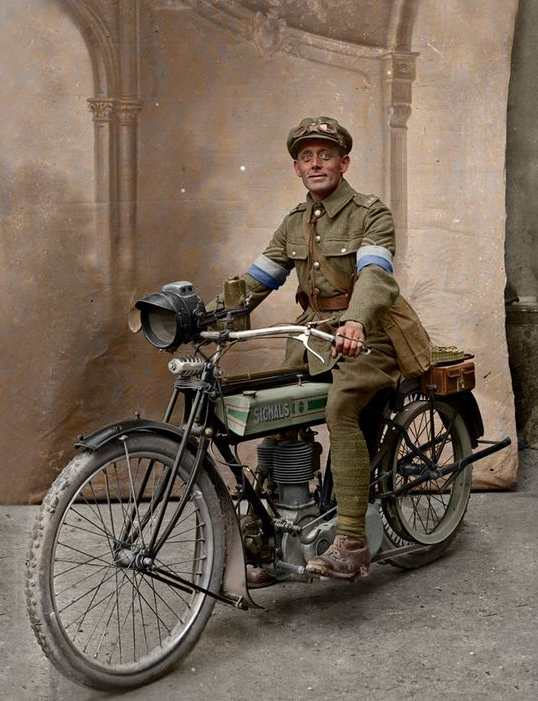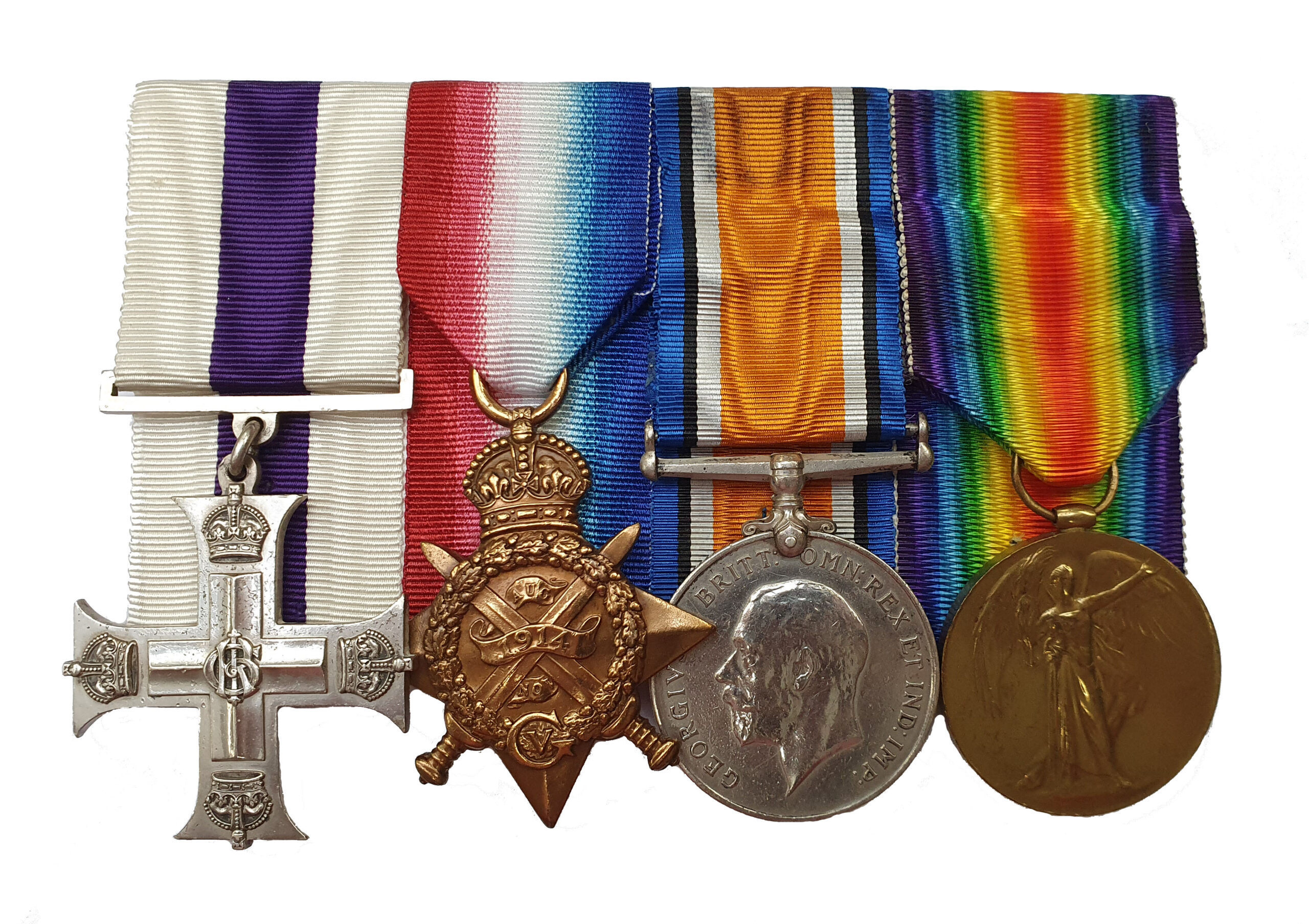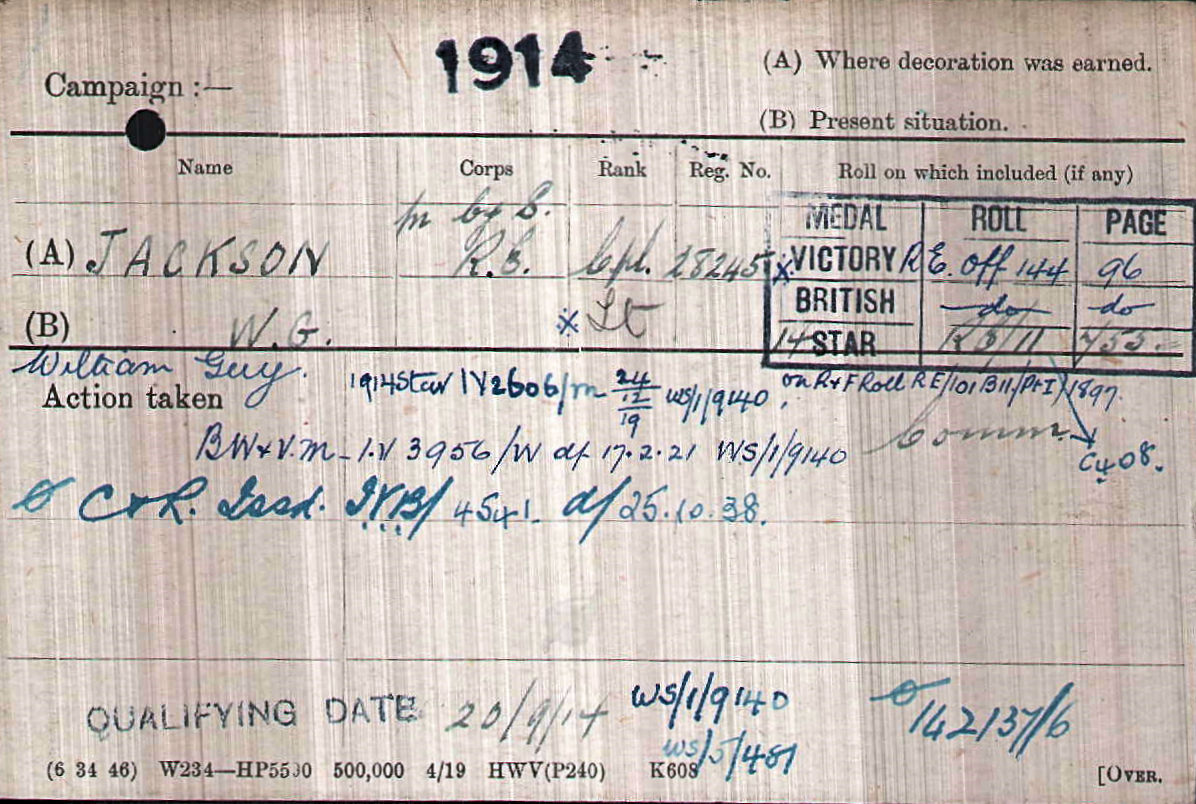
Figure 1. Lieutenant William Guy Jackson, M.C., R.E.
(Image from Wycliffe and the War)
Lieutenant
WILLIAM
GUY JACKSON, M.C.
Royal Engineers
by
Lieutenant Colonel Edward De Santis, MSCE, PE,
MinstRE
(July 2023)

Figure 1. Lieutenant William Guy Jackson, M.C., R.E.
(Image
from Wycliffe and the War)
1. INTRODUCTION
This is the story of a man who fought throughout the Great War of 1914-1918 in the ranks and as an Officer in the Royal Engineers. After the war he retained his commission in the Reserve of Officers and when the Second World War started he was back again in uniform as an officer in the Royal Artillery. His service in the Great War is covered in some detail here, as there are many references to be found that provide such detail. Unfortunately indications of his service during WW2 were only found in Army Lists between 1939 and 1944 where he is listed as an Officer in the Royal Artillery (Territorial Army).
Family Information
William Guy Jackson was born in Bristol, Gloucestershire on 1 October 1894. He was the son of William Jackson (1862-1907) and Emily Florence Jackson, née Guy (1861-1933).
Early Life
As a young man, Guy, as he preferred to be called, attended Wycliffe College. Wycliffe was a public school in Stonehouse, Gloucestershire, founded in 1882 by G. W. Sibly. He was at Wycliffe when the Great War broke out in August 1914 and like many men of his age at the time he immediately joined the Colours.[1]
3. ENLISTMENT AND TRAINING
Enlistment
Guy Jackson enlisted in the Royal Engineers as a Sapper, Regimental Number 28245, in August 1914.
Training
Following the administrative actions involved with his enlistment, Jackson was sent off for his recruit training. With the exception of Drivers, every recruit enlisted for the Royal Engineers had to have a trade. Pioneers and Sappers were sent to Chatham where they were trained for a year in infantry drill and pioneer duties. Every training company in turn went into a tent-camp at Wouldham near Chatham, where the recruits were taught camp duties, pontooning and other field engineering tasks. The engineer recruits also received musketry training. When the course of training was completed the recruits had to pass an examination and were then transferred to engineer formations, where they received higher pay and could earn extra allowances by working at their special trades.
Jackson’s special trade appears to have been communications, perhaps as a linesman or a telegraph operator, or as it turned out in his case, a motorcycle despatch rider.[2] He appears to have excelled in his training as he was promoted to the rank of Corporal before his posting to a company.
Despatch riders were used to deliver urgent orders and messages between headquarters and military units. They had a vital role at a time when telecommunications were limited and insecure. They were also used to deliver carrier pigeons. Motorcycle despatch riders were first used in the Great War by the Royal Engineers Signal Service. When the War Department called for motorcyclists to volunteer with their machines for despatch work at the start of August 1914, the response was huge. It is not known whether Jackson had a machine of his own prior to the war or whether he was issued one by the Army.
Motorcycle despatch riders had one of the most dangerous jobs during the war. Their job was essentially the highest stakes form of motor racing ever devised, with the men needing to race from one location to another delivering critical messages to the officers. With fast moving front lines it was common for despatch riders to find themselves on the wrong side of the line encountering enemy infantry. The ability to ride fast and keep their heads down was vital. In addition to carrying messages, despatch riders were often tasked with performing reconnaissance missions. Their motorcycles were easily maneuverable and were able to get to locations that may have been impassable to wagons or lorries. This allowed riders to deliver key information to commanders at different echelons. They frequently came under intense artillery fire and those riders close to the front lines often drew heavy enemy small arms fire.

Figure 2. A Royal Engineers Motorcycle Despatch
Rider.
(Image courtesy of Wikipedia)
4. POSTINGS AND CAMPAIGN SERVICE
France (1914-1915)
Following the completion of his training, Corporal Jackson was sent to France where he arrived on 20 September 1914.[3] He was immediately posted to the General Headquarters (G.H.Q.) Signal Company of the British Expeditionary Force (B.E.F.) at Montcerf. The company had been in France since 9 August. It had been quickly mobilized to accompany the G.H.Q.
The G.H.Q. Signal company was a small unit, consisting of 5 Officers and 75 Other Ranks. The Company’s mission was to establish and maintain communications between the B.E.F. commander in the field and the War Office, and within the theater of war to provide communications between the B.E.F. commander, the French commander and the British Armies. Naturally, to accomplish this mission the company had to move with and remain in close contact with the B.E.F. headquarters.
In October 1914 the company was at Bailleul and by March 1915 it had moved to Hazebrouck. On 25 September 1915 Jackson and his company were at St. Omer.[4] While in the field with the company Jackson performed his assigned duties in an exceptional manner and demonstrated leadership skills that caused his commander to recommend him for a commission. Jackson returned to England in November 1915 to receive training at the Royal Engineers Signals Officer Training Battalion at Newark, Nottinghamshire.
In February 1916 a new system of training for officers had been introduced, after which temporary commissions could only be granted if a man had been through an Officer Cadet unit. Entrants would have to be aged over 18 and a half, and to have served as a ranker or to have been with an Officer Training Corps unit. The training course lasted four and a half months. The Officer Cadet Battalion had an establishment of 400 cadets at any time (although this was raised to 600 – if the unit could accommodate them – in May 1917). More than 73,000 men gained commissions after being trained in an Officer Training Battalion, with increasing numbers coming from ‘the ranks’ as the war went on.[5] Jackson was one of these men coming from the ranks.
On 31 March 1916, about four and a half months after his return to England from France, Jackson was discharged from the ranks and on the following day he was appointed a Temporary Second Lieutenant in the Royal Engineers.[6]
5. COMMISSIONED SERVICE
France (1916-1919)
In August 1916 Temporary Second Lieutenant Jackson returned to France and was posted to “Y” Corps Signal Company with the ANZAC Corps.[7] The mission of a Corps Signal Company was to establish and maintain communications between the Corps headquarters and the Army headquarters in which it served and in some cases with the subordinate divisions in the Corps. While serving with the ANZAC Corps, Jackson’s company was credited with taking part in the following actions:[8]
· The Battle of Polygon Wood (26 September – 3 October 1917)
· The Battle of Broodseinde (4 October 1917)
· The Battle of Poelcappelle (9 October 1917)
· The Battle of Passchendaele (12 October 1917)
The London Gazette of 19 November 1917 announced the award of the Military Medal to Temporary Second Lieutenant W.G. Jackson with the following citation, perhaps for his performance of duty during the Battle of Passchendaele:
“For conspicuous gallantry and devotion to duty. He displayed great courage and determination in repairing important cable routes under heavy shell fire. This occurred on two consecutive days, and on each occasion he and his party succeeded in completing the task, which was of the greatest value, under most trying circumstances.”
On 12 December 1917 “Y” Corps Signal Company was redesignated the XXII Corps Signal Company. The British XXII Corps was formed in France in December 1917, from what was left of II ANZAC Corps, once the Australian divisions had left to form the Australian Corps.[9] Now, with XXII Corps, Jackson took part in 13 major actions up to the end of the war:[10]
· The Battle of Bailleul (13-15 April 1918)
· The Battle of Kemmel (17-19 April 1918)
· The Battle of Kemmel (25-26 April 1918)
· The Battle of Scherpenberg (29 April 1918)
· The Battle of Tardenois (20-31 July 1918)
· The Battle of the Scarpe (26-30 August 1918)
· The Battle of Drocourt-Queant (2-3 September 1918)
· The Battle of Canal du Nord (27 September – 1 October 1918)
· The Battle of Cambrai (8-9 October 1918)
· The Battle of the Selle (17-25 October 1918)
· The Battle of Valenciennes (1-2 November 1918)
· The Battle of the Sambre (4 November 1918)
· The Pursuit to the Mons (28 September – 11 November 1918)
Jackson returned home for demobilization in December 1918.[11] He received his 1914 Star, named to him as a Corporal, on 24 December 1919 and his British War Medal and Victory Medal named to him as a Lieutenant on 17 February 1921.[12]
MEDALS, AWARDS AND DECORATIONS

Figure 3. The Military Cross, 1914 Star, British War
Medal and Victory Medal.
(Image from the author’s
collection)
NOTE: These are not Jackson’s medals. The image of the medals is shown here for illustrative purposes only.

Figure 4. The Medal Index Card of Lieutenant William Guy
Jackson, M.C., R.E.
(Image courtesy of Ancestry.com)
7. RELEASE FROM SERVICE
Sometime shortly after the end of the Great War it appears that he retained his rank as a Lieutenant and was transferred to the Reserve of Officers.[13] Not much is known about Jackson’s life after the Great War except that he resided in Stroud, Gloucestershire during the 1950s.
8. SERVICE IN WORLD WAR 2
The London Gazette of 23 April 1939 announced that Lieutenant William Guy Jackson, late R.E. was to be appointed a Captain in 76 Anti-Aircraft Regiment, Royal Artillery in the Territorial Army. It appears that he was being called up from the Reserve of Officers for service in the impending conflict with Germany.
76 (Gloucestershire) Anti-Aircraft Brigade RA (TA) was formed in November 1938 by conversion of 66 (South Midland) Field Brigade RA (TA). It was re-designated as 76 Anti-Aircraft Regiment in January 1939, regaining its “Gloucestershire” title in July. In June 1940 it was re-designated as 76 (Gloucestershire) Heavy Anti-Aircraft Regiment RA (TA). It served in the UK until November 1942 when it moved to North Africa. It subsequently served in Sicily and Italy. The Regiment was placed in suspended animation in November 1945.
On 17 January 1941 Jackson was appointed a Temporary Major.[14] By 1942 he had reverted to his rank as a Captain and he remained at that rank for most of the war; that is, until 1944. Unfortunately, without access to his service record it is not possible to know if he served abroad with the regiment in an active theater of the war, or whether he remained at home. He would have been 45 years old when the war started, still young enough to see active service. If he did serve abroad during the war he could possibly have been awarded the 1939-45 Star, Africa Star, Defence Medal and War Medal in addition to his Great War medals.
William Guy Jackson died on 22 October 1986 in Bury St. Edmunds, Suffolk at the age of 92. His address at the time of his death was 43 Jubilee Court, Nowton Road, Bury St. Edmunds. Administration of his Will took place in Ipswich on 22 January 1987, with his effects not exceeding £40,000.
ANNEX A
Casualties of the G.H.Q. Signals Company, Royal Engineers
Name |
|
Rank |
|
Date of Death |
Blackshaw, Alan |
231031 |
Pioneer |
|
5 Apr 1917 |
Longbottom, H. |
230634 |
Pioneer |
|
19 Jul 1917 |
Chivers, H. |
282017 |
Pioneer |
|
2 Nov 1917 |
Dunn, Harold Hugh |
74592 |
Corporal |
|
20 Dec 1917 |
Mitton, Thomas Ewart |
|
Lieutenant |
|
24 Dec 1917 |
Dolan, Frank |
165974 |
Sapper |
|
28 Mar 1918 |
Collie, Alexander |
1644 |
Sergeant Major |
|
3 Jun 1918 |
Handscomb, Ernest |
77731 |
Corporal |
|
18 Jun 1918 |
French, William George |
268187 |
Sapper |
|
3 Oct 1918 |
Henderson, W. |
|
Lieutenant |
|
29 Oct 1918 |
Carroll, Lawrence |
195140 |
Sapper |
|
10 Nov 1918 |
Parkes, Gilbert Frederick |
24284 |
Corporal |
|
24 Nov 1918 |
Collins, John James Joseph |
278685 |
Lance Corpl. |
|
12 Dec 1918 |
Roberts, John Sidney |
28155 |
Corporal |
|
27 Jan 1919 |
Legend: KIA – Killed in Action; DOW – Died of Wounds; Died – of disease or accidentally killed.
ANNEX B
Casualties of the “Y” Corps Signal Company, Royal Engineers
Name |
|
Rank |
|
Date of Death |
Berriff, Bruce |
72366 |
Sergeant |
|
29 Sep 1917 |
White, Harold Edward |
245717 |
Sapper |
|
3 Mar 1918 |
Sproat, Ashton |
46968 |
Corporal |
|
2 Jul 1918 |
Legend: KIA – Killed in Action; DOW – Died of Wounds; Died – of disease or accidentally killed.
REFERENCES:
Army Lists
Army List, June 1919, p. 812a.
Army List, December 1920.
Army List, June 1926.
Army List, October 1935.
Army List, April 1938.
Army List, May 1940, p. 494a.
Army List, 4th Quarter 1941, p. 493c.
Army List, 4th Quarter 1942, p. 493c.
Army List, 4th Quarter 1943, p. 493c.
Army List, 4th Quarter 1944, p. 493c.
Army List, August 1949.
Books
History of the Corps of Royal Engineers, Volume V. The Institution of Royal Engineers, Chatham, Kent, 1952.
Work of the R.E. In the European War, 1914-1919. The Signal Service (France). The Institution of Royal Engineers, Chatham, Kent, 1952.
Wycliffe and the War: Privately Printed by John Bellows, Gloucester; First Edition (January 1, 1923).
Civil Documents
Electoral Registers, Stroud, Gloucestershire, 1950 to 1956.
Probate Calendar, 1987, p. 4143.
Internet Web Sites
Ancestry.com
The Royal Artillery, 1939-1945. 76 (Gloucestershire) Heavy Anti-Aircraft Regiment RA (TA).
The Long, Long Trail. British Expeditionary Force General Headquarters.
https://www.longlongtrail.co.uk/british-expeditionary-force-general-headquarters/
The Long, Long Trail. Officer Training in the British Army of 1914-1918.
London Gazette
Supplement to the London Gazette, 1 April 1916, p. 3521.
Supplement to the London Gazette, 19 November 1917, pp. 11951 and 11952.
Supplement to the London Gazette, 22 March 1918, pp. 3596 and 3603.
The London Gazette, 25 April 1939, p. 2752.
Military Documents
Royal Engineers Medal Roll, 1914 Star, G.H.Q. Company, Motor Cyclist Section, 15 July 1918.
Royal Engineers Medal Roll, British War Medal and Victory Medal.
Medal Index Card.
Periodicals
Battle Honours of the Royal Engineers. The Royal Engineers Journal. The Institution of Royal Engineers, Chatham, Kent, 1925-1932.
ENDNOTES:
[1] Immediately the War broke out almost half of the former pupils who had left Wycliffe in the previous 30 years joined the Forces. By the end of the War around 550 Old Wycliffians had served. Of those 77 had died. Six D.S.O.s, 37 Military Crosses, 4 Crosses for flying, 17 other military awards and 36 “mentions in despatches” had been awarded.
[2] Medal roll for the 1914 Star.
[3] Medal Index Card.
[4] The Long, Long Trail.
[5] The Long, Long Trail: Officer Training.
[6] London Gazette, 1 April 1916.
[7] Medal Index Card and Wycliffe and the War.
[8] Battle Honours of the Royal Engineers.
[9] MIC and Wikipedia.
[10] Battle Honours of the Royal Engineers.
[11] Wycliffe and the War.
[12] Medal rolls.
[13] He appears to have received a promotion to Lieutenant at this time because he appears on the British War Medal and Victory Medal roll as a Lieutenant.
[14] Army List, 1941.